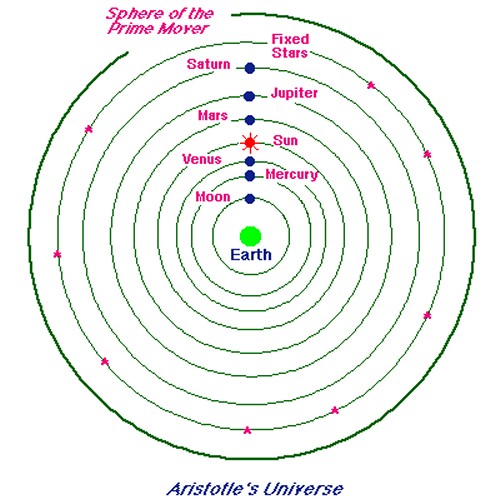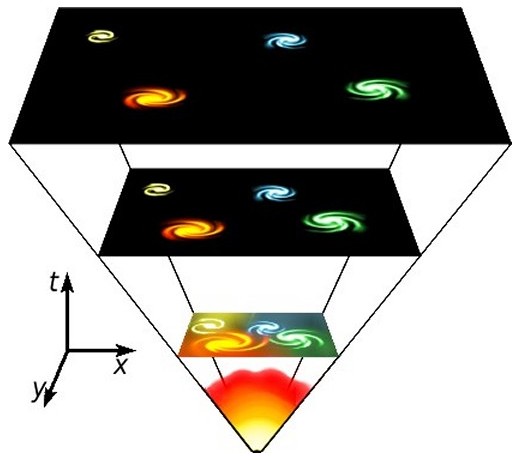
|
Main Topics > The Big Bang and the Big Crunch > The Expanding Universe and Hubble's Law
When Albert Einstein was formulating his ground-breaking theory of gravity in the early 20th Century, at a time when astronomers only really knew of the existence of our own galaxy, he necessarily used the simplifying assumption that the universe has the same gross properties in all parts, and that it looks roughly the same in every direction wherever in the universe an observer happens to be located. Like Sir Isaac Newton two hundred years before him, he assumed an infinite, static or “steady state” universe, with its stars suspended essentially motionless in a vast void. However, when Einstein tried to apply his General Theory of Relativity to the universe as a whole, he realized that space-time as a whole must be warped and curved back on itself, which in itself would cause matter to move, shrinking uncontrollably under its own gravity. Thus, as early as 1917, Einstein and others realized that the equations of general relativity did not describe a static universe. However, he never quite came to terms with the idea of a dynamic, finite universe, and so he posited a mysterious counteracting force of cosmic repulsion (which he called the “cosmological constant”) in order to maintain a stable, static universe. Adding additional and arbitrary terms to a theory is not something that scientists do lightly, and many people argued that it was an artificial and arbitrary construct and at best a stop-gap solution.
As we have noted, up until that time, the assumption of a static universe had always been taken for granted. To put things into perspective, for most of history (see the section on Cosmological Theories Through History), it had been taken for granted that the static earth was the center of the entire universe, as Aristotle and Ptolemy had described. It was only in the mid-16th Century that Nicolaus Copernicus showed that we were not the center of the universe at all (or even of the Solar System for that matter!). It was as late as the beginning of the 20th Century that Jacobus Kapteyn’s observations first suggested that the Sun was at the center of a spinning galaxy of stars making up the Milky Way. Then, in 1917, humanity suffered a further blow to its pride when Curtis Shapely revealed that we were not even the center of the galaxy, merely part of some unremarkable suburb of the Milky Way (although it was still assumed that the Milky Way was all there was). Some years later, in 1925, the American astronomer Edwin Hubble stunned the scientific community by demonstrating that there was more to the universe than just our Milky Way galaxy and that there were, in fact, many separate islands of stars - thousands, perhaps millions of them, and many of them huge distances away from our own. Then, in 1929, Hubble announced a further dramatic discovery which completely turned astronomy on its ear. With the benefit of improved telescopes, Hubble started to notice that the light coming from these galaxies was shifted a little towards the red end of the spectrum due to the Doppler effect (known as “redshift”), which indicated that the galaxies were moving away from us. After a detailed analysis of the redshifts of a special class of stars called Cepheids (which have specific properties making them useful as “standard candles” or distance markers), Hubble concluded that the galaxies and clusters of galaxies were in fact flying apart from each other at great speed, and that the universe was therefore definitively growing in size. In effect, all the galaxies we see are slightly red in color due to redshift. Hubble showed that, in our expanding universe, every galaxy is rushing away from us with a speed which is in direct proportion to its distance, known as Hubble’s Law, so that a galaxy that is twice as far away as another is receding twice as fast, one ten times as far away if receding ten times as fast, etc. The law is usually stated as v = H0D, where v is the velocity of recession, D is the distance of the galaxy from the observer and H0 is the Hubble constant which links them. The exact value of the Hubble constant itself has long been the subject of much controversy: Hubble's initial estimates were of the order of approximately 500 kilometers per second per megaparsec (equivalent to about 160 km/sec/million light years); the most recent best estimates, with the benefit of the Hubble Telescope and the WMAP probe, is around 72 kilometers per second per megaparsec. (It should perhaps be pointed out that the Hubble constant is technically a parameter, not a constant, because it will actually change over long periods of time.)
This expansion, usually referred to as the "metric expansion" of space, is a “broad-brush effect” in that individual galaxies themselves are not expanding, but the clusters of galaxies into which the matter of the universe has become divided are becoming more widely separated and more thinly spread throughout space. Thus, the universe is not expanding "outwards" into pre-existing space; space itself is expanding, defined by the relative separation of parts of the universe. Returning to the image of the expanding universe as a balloon inflating, if tiny dots are painted on the ballon to represent galaxies, then as the balloon expands so the distance between the dots increases, and the further apart the dots the faster they move apart. Another analogy often used (and maybe even clearer) is that of a raisin cake expanding as it bakes, so that the raisins (galaxies) gradually all move away from each other. In such an expansion, then, the universe continues to look more or less the same from every galaxy, so the fact that we see all the galaxies receding from us does not necessarily mean that we are at the very center of the universe: observers in all other galaxies would also see all the other galaxies flying away according to the same law, and the pattern of galactic dispersal would appear very much the same from anywhere in the cosmos. The old model of a static universe, which had served since Sir Isaac Newton, was thus proved to be incontrovertibly false, but Hubble’s discovery did more than just show that the universe was changing over time. If the galaxies were flying apart, then clearly, at some earlier time, the universe was smaller than at present. Following back logically, like a movie played in reverse, it must ultimately have had some beginning when it was very tiny indeed, an idea which gave rise to the theory of the Big Bang. Although now almost universally accepted, this theory of the beginnings of the universe was not immediately welcomed by everyone, and several strands of corroborating evidence were needed, as we will see in the following sections. In the face of Hubble’s evidence, Einstein was also forced to abandon his idea of a force of cosmic repulsion, calling it the “biggest blunder” he had ever made. But others, notably the Russian physicist Alexander Friedmann and the Belgian priest and physicist Georges Lemaître, had already used Einstein’s own theory of proof that the universe was in fact in motion, either contracting or expanding. It is now recognized that Einstein’s description of gravity as the curvature of space-time in his General Theory of Relativity was actually one of the first indications of a universe which had grown out of much humbler beginnings. And, as we will see later, Einstein’s “biggest blunder” may actually turn out to have been one of his most prescient predictions.
|
Back to Top of Page
Introduction | Main Topics | Important Dates and Discoveries | Important Scientists | Cosmological Theories | The Universe By Numbers | Glossary of Terms | A few random facts | Blog | Gravitational Lensing Animation | Angular Momentum Calculator | Big Bang Timeline
NASA Apps - iOS | Android
The articles on this site are © 2009-.
If you quote this material please be courteous and provide a link.
Citations | Sources | Privacy Policy

